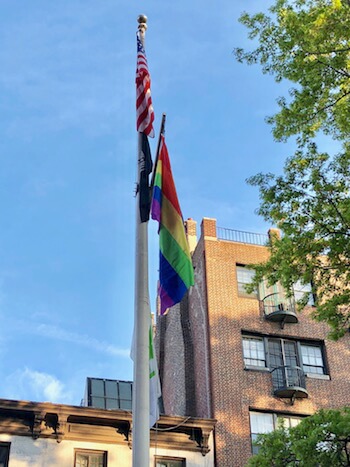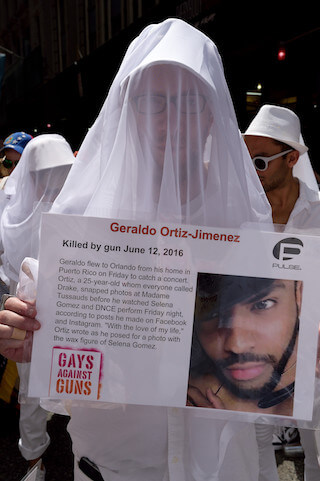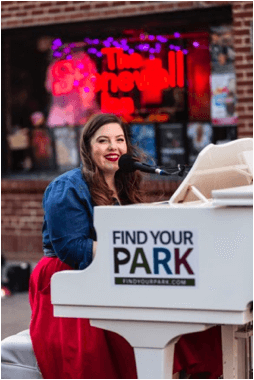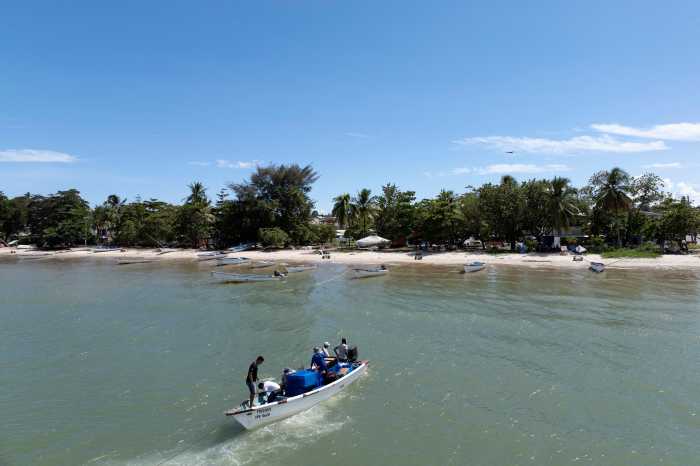Jay Shockley and Ken Lustbader of the NYC LGBT Historic Sites Project. | DUNCAN OSBORNE
While the 1969 riots that began as the result of a police raid at the Stonewall Inn are well known as marking the start of the modern LGBTQ rights movement, what is less well known is that the deputy inspector who led that raid had busted the Mafia-run bar just three days earlier and would lead another raid at a different gay bar nearly a year later that almost resulted in the death of a gay man who was arrested.
“There was a young Argentinian man, Diego Vinales, who panicked that he was going to be deported,” said Jay Shockley, a project director at the NYC LGBT Historic Sites Project, during a recent brief tour of some sites in the West Village.
Shockley was standing near the intersection of Bleecker Street and West 10th Street across from where the Snake Pit was once located.
Historic Sites Project documenting signposts in New York’s queer geography
Seymour Pine, a deputy inspector in the NYPD’s public morals division, had learned from his raid on the Stonewall Inn and chose to hold the 167 men he would eventually arrest inside the Snake Pit. Vinales, who had overstayed his visa, was among them.
Once transported to the 6th Precinct, Vinales tried to flee by jumping from a higher floor in the police station to the roof of a nearby building. He missed the roof and fell. He was impaled on a fence below.
The callous response of the police and the continued harassment by police — the Snake Pit was Pine’s third gay bar raid that week and his fifth known raid altogether — prompted an outcry by the community.
As Vinales lay recuperating from surgery at St. Vincent’s Hospital, members of the Gay Activists Alliance and the Gay Liberation Front organized a vigil and protest that drew several hundred people. They marched on the precinct, then to the hospital, and back to Christopher Park, which is across Christopher Street from the Stonewall Inn. It was an extraordinary achievement by the nascent LGBTQ rights movement.
“Unlike Stonewall, it got press, it got sympathetic press,” Shockley said.
The Rainbow Flag now flies on the Elmer Ephraim Ellsworth flagpole at Christopher Park, designated in 2016 as the site of the Stonewall National Monument. | DONNA ACETO
These kinds of granular details concerning the LGBTQ community’s history are very much a part of the project’s work. Andrew Dolkart and Ken Lustbader are the other project directors and Amanda Davis is the project manager.
The project, which is a “scholarly initiative and educational resource,” was founded in 2015 and to date has identified dozens of locations in the five boroughs that have some significance in the LGBTQ community’s history. It is funded by the New York Community Trust, the Arcus Foundation, the state parks department, and other entities.
“We’re really showing that LGBT history is American history,” Lustbader said during the tour, which began in Christopher Park. The park has what may be a gay link to the Civil War.
The flagpole in the park commemorates Elmer Ephraim Ellsworth, who was the first Union officer killed in that war. When Ellsworth was alive, he was a friend of Abraham Lincoln. Given that some in the LGBTQ community believe that Lincoln may have been America’s first gay president, it is amusing to speculate that their relationship was more than friendship. Lustbader and Shockley did not indulge in such speculation during the tour, but they did made a point of pausing to discuss the flagpole, its commemorative plaque, and Ellsworth’s connection to Lincoln.
The project also belongs to the Stonewall 50 Consortium, a group of nearly 70 institutions that are committed to producing programming for next year’s 50th anniversary of the 1969 riots.
The Consortium member organizations cannot dictate the content or timing of other members’ work, but their meetings mean that they will avoid duplicative programs. The effort is chaired by author Eric Marcus.
“I’ve been stunned by the level of interest by so many organizations and institutions in marking the 50th anniversary of Stonewall through some sort of programming and/ or exhibitions,” Marcus wrote in an email to Gay City News. “And I’ve been thrilled to witness the level of interaction and cross-pollination and collaboration that inevitably occurs at our every-other-month in-person meetings.”
While Marcus is a volunteer, the New York Community Trust has provided $50,000 for administration costs for the Consortium. The 50th anniversary also means more walking for Lustbader and Shockley.
“We are going to schedule tours and presentations… and we’re trying to adapt what we do to an app so people can do what we do without us being in the field,” Lustbader said.






































